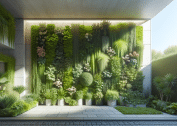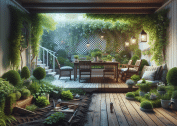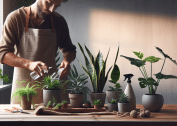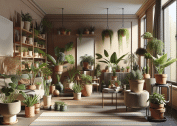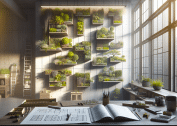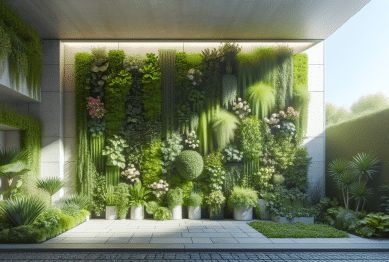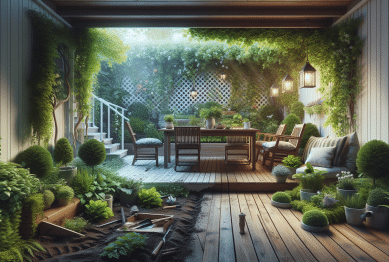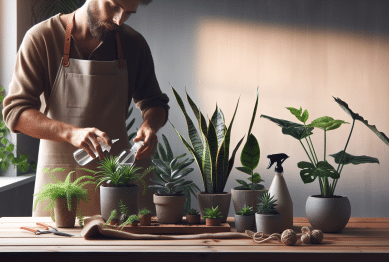Discover the secrets behind lush, healthy indoor plants and why houseplant care matters for indoor air quality and happiness. This guide reveals practical tips, common pitfalls, and easy care routines anyone can use to build a stunning green sanctuary at home.
Why Indoor Plants Matter More Than Ever
Indoor plants do more than add a pop of green to living spaces. They help improve air quality, which many overlook when creating a healthy home. Research shows that common houseplants like pothos, peace lilies, and spider plants are particularly effective at filtering out volatile organic compounds and pollutants, making the indoor environment fresher and potentially safer. For residents in apartments or homes with limited outdoor access, having indoor greenery can be a game changer for both aesthetics and wellness.
Beyond physical health, houseplants are linked to mental and emotional benefits. Greenery has been found to reduce feelings of stress and enhance productivity—qualities especially valued in today’s work-from-home culture. Whether on your desk or in the kitchen, just a few plants can brighten a space and help foster a sense of calm. This is why designers often recommend houseplant care as a simple way to personalize living environments. The presence of thriving green leaves offers comfort during hectic routines.
Not every room is created equal for indoor gardening. Factors such as light flow, humidity, and airflow can greatly influence plant vitality. Selecting the right species for each room is crucial—direct sunlight lovers belong near bright windows, while low-light species thrive in shaded corners. Understanding these needs ensures every plant receives the care required, creating a healthy green space that offers benefits to all inhabitants. Proper placement and species selection lay the groundwork for flourishing indoor gardens.
Choosing the Right Houseplants for Your Space
Success with indoor gardening starts with choosing plants that fit your household’s conditions. People often gravitate toward popular species such as snake plants, philodendrons, or ZZ plants because they tolerate a range of environments and require less maintenance. These easy-care options suit new plant owners as well as frequent travelers. Choosing resilient plants helps ensure long-term success, resulting in less frustration and a higher chance of green thumb triumph.
It’s important to assess your home’s light sources before bringing in new plants. North-facing rooms often lack the brightness needed for light-hungry varieties, so selecting low-light houseplants for those areas increases the odds of success. Meanwhile, a sunny south-facing window can support more exotic greenery. Noticing the shifting light patterns helps optimize where each plant will thrive, so time invested in observation pays off over the long run.
Don’t overlook the size and growth habits of your chosen species. Some indoor plants, such as monsteras and rubber trees, can grow quite large and eventually overtake small living rooms if left unchecked. Compact options are better for shelves or window sills. Researching species’ maximum height or spread before purchase helps keep your space organized and prevents crowding, saving you from future rearranging or unexpected pruning tasks.
Secrets of Light and Water for Lush Growth
Lighting is the most misunderstood factor in houseplant care. Many assume all plants thrive in direct sun, but most common houseplants evolved under the shaded canopies of rainforests. Too much sunlight can scorch delicate leaves, while too little stalls growth. Observing the light patterns in your home and matching plant choices accordingly establishes an environment where greenery can thrive year-round. Indirect light suits the majority of popular indoor species.
Watering routines demand careful attention. Overwatering is a leading cause of plant decline, often occurring when owners water on a fixed schedule instead of checking soil moisture. Using your finger to test soil before watering prevents soggy roots and fungal issues. Equally, under-watering leaves plants dry and droopy. Finding a balance may take some trial and error, but establishing a habit of regular monitoring creates consistently healthy growth.
Humidity frequently impacts plant vitality, particularly for tropical species. In arid homes, leaves may brown at the edges or curl inward. Simple practices, like grouping plants together or placing trays of water nearby, increase moisture in the air. Owners who use humidifiers or regularly mist certain species often see more robust and glossy foliage. This subtle tweak in your home’s microclimate supports stronger roots and vibrant leaves, especially through dry winter months.
Feeding, Repotting, and the Importance of Soil
Nutrition is an underrated but essential part of indoor plant care. Many houseplants exhaust soil nutrients after just a few months, leading to pale leaves or weak stems. Using a diluted, balanced fertilizer during active growing seasons—typically spring through early autumn—can rejuvenate vigor. Taking cues from plant appearance, such as faded color or slow growth, signals when nourishment is appropriate, preventing both deficiencies and fertilizer burn.
Root space matters. Over time, roots outgrow their containers and become “pot-bound,” causing drainage and growth problems. Telltale roots poking from the drainage holes indicate the need for repotting. Repotting refreshes the growing medium and offers roots breathing room, which contributes to noticeable growth spurts. This process can feel intimidating, but it’s a straightforward routine that helps sustain healthy plants for years.
Soil quality deserves as much attention as water or light. Well-draining potting mixes tailored for the selected plant species minimize the risks of root rot while retaining enough moisture for sustained hydration. Indoor gardeners can find commercial blends designed for tropical species, succulents, or orchids. Investing in high-quality soil or amending basic potting mix with perlite or peat boosts root health and resists common pests and diseases.
Common Indoor Plant Mistakes and How to Avoid Them
One frequent misstep when caring for houseplants is reacting too quickly to cosmetic issues, like yellow leaves or leaf drops. Many times, these are part of natural life cycles or responses to small environmental changes and not reasons for panic. Understanding that not every blemish means disaster reduces unnecessary interventions, letting plants recover on their own and build resilience over time. Observation is key, not over-action.
Pest infestations also worry many. Small insects like spider mites or fungus gnats appear in dry, stagnant conditions. Regular inspection, maintaining airflow, and using sticky insect traps prevent outbreaks before they become serious. When issues do arise, non-toxic remedies, such as diluted soap sprays, offer safe solutions for both humans and plants. Early detection and gentle treatment minimize stress to your indoor garden.
Another easy-to-make mistake is neglecting seasonal adjustments. During colder months, growth slows and plants require less water and food. Keeping plants on a summer routine in winter increases risks of rot or pest problems. Gradually dialing back watering and fertilizer during dormancy mimics natural cycles and keeps plants robust year after year. Observing and adapting routines as seasons change supports lasting indoor plant health.
Curating Your Healthy Indoor Jungle: Advanced Tips
Once basics are mastered, enthusiasts often experiment with less common or more demanding species. Growing rare aroids, trailing vines, or flowering houseplants adds visual diversity but demands added research. Joining local gardening groups, following botanical gardens online, or connecting with expert forums can provide practical support and inspiration. Community knowledge lifts success rates for cultivating challenging indoor plants and opens the door to new varieties.
Arranging plants in creative displays, such as hanging baskets, wall-mounted planters, or grouped collections, transforms rooms and maximizes growing conditions. Mixing leaf shapes, sizes, and growth habits also crafts naturalistic, appealing arrangements. Rotating plant placement for balanced light exposure and periodic rearrangement ensures uniform growth, preventing lopsided or weakly developed specimens. Thoughtful layout paired with attentive care yields dramatic results indoors.
Lastly, learning to propagate by cuttings, division, or seed is a satisfying way to expand a collection without extra cost. Sharing propagated plants with friends or trading within plant communities fosters connection and continues the cycle of indoor gardening. This hands-on approach deepens appreciation for plant biology and sustains interest in the evolving world of houseplants, turning any space into a miniature green haven.
References
1. NASA. (n.d.). Interior Landscape Plants for Indoor Air Pollution Abatement. Retrieved from https://ntrs.nasa.gov/citations/19930073077
2. American Psychological Association. (2020). Houseplants and Well-being. Retrieved from https://www.apa.org/monitor/2020/04/houseplants-wellbeing
3. University of Vermont Extension. (n.d.). Indoor Plant Care. Retrieved from https://pss.uvm.edu/ppp/articles/indoor.html
4. North Carolina State University Extension. (2021). Growing Indoor Plants with Success. Retrieved from https://content.ces.ncsu.edu/growing-indoor-plants-with-success
5. Royal Horticultural Society. (n.d.). Houseplant Care Guide. Retrieved from https://www.rhs.org.uk/advice/profile?pid=755
6. University of Minnesota Extension. (n.d.). Growing Indoor Plants Year-Round. Retrieved from https://extension.umn.edu/houseplants/growing-indoor-plants


